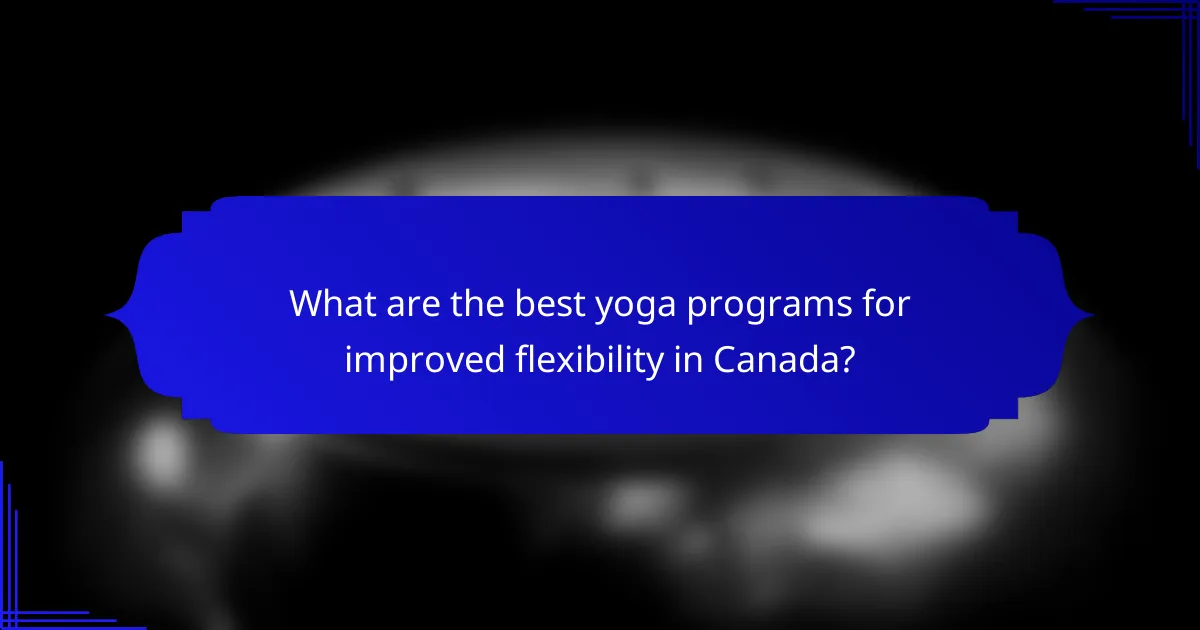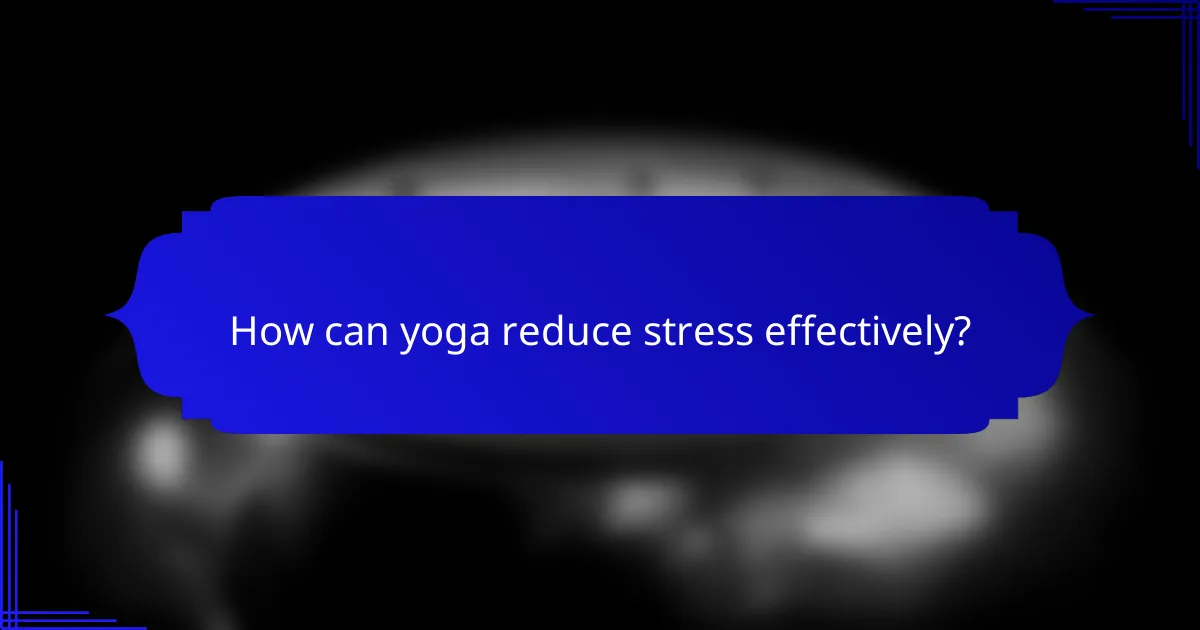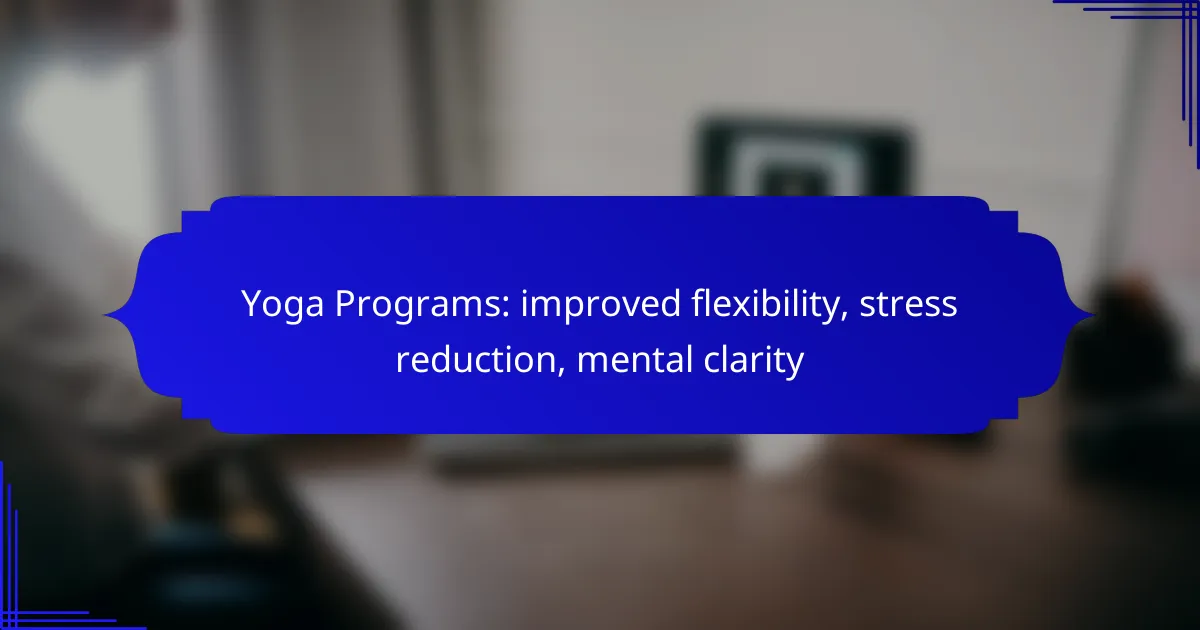Yoga programs offer a holistic approach to enhancing flexibility, reducing stress, and improving mental clarity. By incorporating various styles and techniques, these programs focus on stretching muscles, promoting relaxation, and cultivating mindfulness. Participants can experience greater physical ease, emotional balance, and sharper cognitive abilities through dedicated practice.

What are the best yoga programs for improved flexibility in Canada?
The best yoga programs for improved flexibility in Canada include various styles that cater to different needs and preferences. These programs focus on stretching and lengthening muscles, often incorporating breathwork and mindfulness to enhance the experience.
Hatha Yoga
Hatha Yoga is a foundational style that emphasizes basic postures and alignment, making it ideal for beginners. Classes typically include a mix of standing, seated, and supine poses, all designed to promote flexibility and balance.
To get the most out of Hatha Yoga, aim for sessions that last between 60 to 90 minutes, allowing ample time to hold poses and deepen stretches. Look for classes that focus on breath control, as this can significantly enhance flexibility.
Vinyasa Yoga
Vinyasa Yoga is characterized by its dynamic flow, linking breath with movement. This style encourages flexibility through a series of poses that transition smoothly, often incorporating sun salutations.
For improved flexibility, consider participating in Vinyasa classes that emphasize longer holds in key poses like downward dog and pigeon. Practicing 2 to 3 times a week can yield noticeable improvements in your flexibility over time.
Yin Yoga
Yin Yoga focuses on deep stretching and targets the connective tissues, promoting flexibility in a gentle manner. Poses are typically held for several minutes, allowing for a profound release of tension.
Incorporating Yin Yoga into your routine once a week can complement more active styles, helping to enhance overall flexibility. Look for classes that incorporate props like bolsters and blocks to support your practice.
Ashtanga Yoga
Ashtanga Yoga is a rigorous style that follows a set sequence of poses, promoting strength and flexibility simultaneously. This practice is physically demanding and can lead to significant gains in flexibility over time.
To effectively practice Ashtanga, commit to a regular schedule, ideally practicing 3 to 5 times a week. Be mindful of your body’s limits, and consider modifying poses as needed to prevent injury while still challenging yourself.
Restorative Yoga
Restorative Yoga is a gentle practice that uses props to support the body in restful poses, allowing for deep relaxation and gradual stretching. This style is particularly beneficial for those looking to improve flexibility without intense physical exertion.
Participating in Restorative Yoga classes once a week can help alleviate tension and enhance flexibility. Focus on breath awareness and mindfulness during these sessions to maximize the benefits.

How can yoga reduce stress effectively?
Yoga can effectively reduce stress by promoting relaxation, enhancing mindfulness, and improving overall mental clarity. Through various techniques, yoga helps individuals manage stress responses and cultivate a sense of calm.
Mindfulness-Based Stress Reduction
Mindfulness-Based Stress Reduction (MBSR) incorporates meditation and yoga to help individuals focus on the present moment. This practice encourages awareness of thoughts and feelings without judgment, which can significantly lower stress levels.
Typically, MBSR programs last around eight weeks and include weekly classes and daily home practices. Participants often report feeling more grounded and less reactive to stressors after completing the program.
Gentle Yoga Classes
Gentle yoga classes focus on slow movements and deep breathing, making them accessible for all fitness levels. These classes are designed to ease tension in the body and promote relaxation, which can be particularly beneficial for those experiencing high stress.
Common styles include Hatha and Yin yoga, which emphasize stretching and holding poses for longer periods. Practicing gentle yoga regularly can lead to improved flexibility and a calmer mind.
Yoga Nidra
Yoga Nidra, or yogic sleep, is a guided meditation practice that induces deep relaxation while maintaining awareness. This technique allows practitioners to enter a state of consciousness between waking and sleeping, which can help alleviate stress and anxiety.
Sessions typically last 30 to 45 minutes and can be done lying down comfortably. Regular practice can lead to significant improvements in sleep quality and emotional resilience.
Power Yoga
Power yoga is a vigorous style that combines strength and flexibility training with breath control. This dynamic practice can be an effective way to release pent-up stress while also building physical endurance.
While it may not be as calming as other forms of yoga, the intense physical activity can lead to the release of endorphins, promoting a sense of well-being. Practitioners should ensure they balance power yoga with restorative practices to avoid burnout.

What are the benefits of yoga for mental clarity?
Yoga enhances mental clarity by promoting relaxation and reducing stress, which allows for clearer thinking and better decision-making. Through various poses and breathing techniques, practitioners can improve their focus and cognitive abilities.
Improved Focus
Practicing yoga can significantly enhance focus by training the mind to concentrate on the present moment. Techniques such as breath control and meditation help minimize distractions, allowing individuals to engage more fully in tasks. Regular practice can lead to longer periods of sustained attention.
To maximize focus during yoga, consider setting a specific intention for each session. This could be as simple as dedicating time to a particular task or thought, which can help reinforce concentration skills off the mat.
Enhanced Cognitive Function
Yoga has been linked to improvements in cognitive function, including better memory and problem-solving skills. The combination of physical movement and mindfulness encourages brain health by increasing blood flow and oxygen to the brain.
Incorporating poses that require balance and coordination can further stimulate cognitive processes. For example, practicing tree pose or warrior III not only strengthens the body but also engages the mind in maintaining stability.
Emotional Regulation
Yoga promotes emotional regulation by fostering a deeper connection between the mind and body. Through mindful breathing and meditation, individuals learn to recognize and manage their emotions more effectively, reducing anxiety and stress levels.
To enhance emotional regulation, focus on restorative yoga practices that emphasize relaxation and introspection. Techniques such as guided imagery or gentle stretches can create a calming environment conducive to emotional awareness.
Increased Mindfulness
Increased mindfulness is a core benefit of yoga, as it encourages practitioners to be present and aware of their thoughts and feelings. This heightened state of awareness can lead to better decision-making and a more balanced emotional state.
To cultivate mindfulness, try integrating short meditation sessions into your yoga routine. Even a few minutes of focused breathing can enhance your ability to stay present, both during practice and in daily life.

What should I consider when choosing a yoga program?
When selecting a yoga program, consider factors like instructor qualifications, class size, program structure, and location accessibility. These elements significantly impact your experience and the benefits you can gain, such as improved flexibility, stress reduction, and mental clarity.
Instructor Qualifications
Look for instructors with recognized certifications and experience in teaching yoga. Many reputable programs require instructors to have completed a minimum of 200 hours of training, often through organizations accredited by the Yoga Alliance.
Additionally, consider the instructor’s specialization. Some may focus on specific styles, such as Hatha, Vinyasa, or Yin yoga, which can influence the type of practice you will experience.
Class Size
Class size can greatly affect the quality of your yoga practice. Smaller classes, typically ranging from 5 to 15 participants, allow for more personalized attention and adjustments from the instructor.
Larger classes may offer a more energetic atmosphere but can limit individual feedback. If you are new to yoga or seeking specific guidance, opt for smaller class sizes to enhance your learning experience.
Program Structure
Evaluate the program’s structure, including the duration and frequency of classes. Many programs offer sessions that last between 60 to 90 minutes, with classes held weekly or multiple times a week.
Consider whether the program includes a progression plan, allowing you to build on your skills over time. A well-structured program should also incorporate elements that promote flexibility, stress reduction, and mental clarity.
Location Accessibility
Accessibility is crucial when choosing a yoga program. Ensure the studio is conveniently located, whether it’s near your home or workplace, to encourage regular attendance.
Additionally, consider if the studio offers online classes or hybrid options, which can provide flexibility in your schedule and allow you to practice from the comfort of your home when needed.

How do local yoga studios in Canada compare?
Local yoga studios in Canada vary widely in their offerings, pricing, and class styles. Many studios focus on improving flexibility, stress reduction, and mental clarity, but the approach and environment can differ significantly.
Class Offerings
Yoga studios in Canada typically offer a range of classes, including Hatha, Vinyasa, and Yin yoga. Some may specialize in therapeutic yoga or classes designed for specific populations, such as seniors or athletes. It’s common to find studios that provide workshops and special events to deepen practice.
When choosing a studio, consider the variety of classes available and whether they align with your personal goals, such as enhancing flexibility or reducing stress. Many studios also offer introductory packages or drop-in rates, making it easier to try different classes before committing.
Pricing Structures
Pricing for yoga classes in Canada can vary from around CAD 15 to CAD 30 per class, with discounts often available for multi-class passes or memberships. Some studios may offer sliding scale fees or community classes at reduced rates, making yoga more accessible.
When evaluating costs, consider how often you plan to attend classes. A monthly membership might be more economical if you practice regularly, while occasional practitioners may benefit from drop-in rates or class packs.
Instructor Qualifications
In Canada, yoga instructors typically complete a minimum of 200 hours of training, often accredited by Yoga Alliance or similar organizations. Many instructors continue their education with specialized training in areas like anatomy, meditation, or specific yoga styles.
Researching instructor qualifications can help ensure you receive quality guidance. Look for studios that highlight their instructors’ credentials and experience, particularly if you’re seeking classes focused on stress reduction or mental clarity.
Studio Environment
The atmosphere of a yoga studio can significantly impact your experience. Many Canadian studios emphasize a welcoming and inclusive environment, with amenities like changing rooms, showers, and relaxation areas. Some may incorporate elements like natural lighting, plants, or calming music to enhance the practice.
When visiting studios, pay attention to the overall vibe and cleanliness. A supportive environment can enhance your practice, making it easier to focus on improving flexibility and reducing stress.
